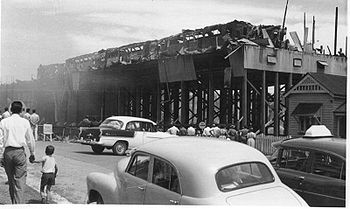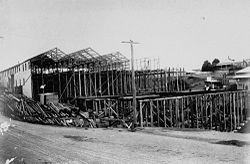
Paddington tram depot fire
Encyclopedia

Tram
A tram is a passenger rail vehicle which runs on tracks along public urban streets and also sometimes on separate rights of way. It may also run between cities and/or towns , and/or partially grade separated even in the cities...
depot
Train station
A train station, also called a railroad station or railway station and often shortened to just station,"Station" is commonly understood to mean "train station" unless otherwise qualified. This is evident from dictionary entries e.g...
in Brisbane
Brisbane
Brisbane is the capital and most populous city in the Australian state of Queensland and the third most populous city in Australia. Brisbane's metropolitan area has a population of over 2 million, and the South East Queensland urban conurbation, centred around Brisbane, encompasses a population of...
, Australia
Australia
Australia , officially the Commonwealth of Australia, is a country in the Southern Hemisphere comprising the mainland of the Australian continent, the island of Tasmania, and numerous smaller islands in the Indian and Pacific Oceans. It is the world's sixth-largest country by total area...
was destroyed by fire on the night of 28 September 1962, one of the largest fires in Brisbane's history. Sixty-five of Brisbane's trams were destroyed. The destruction of the depot is generally seen as the beginning of the end for Brisbane's tram system
Trams in Brisbane
The Brisbane tramway network once served Brisbane, the capital city of Queensland, Australia. It operated between 1885 and 1969 and ran on standard gauge track. The electric system was originally energised to 500 volts, and subsequently increased to 600 volts. All tramcars built in Brisbane up to...
, providing the justification for the subsequent closure of four tram routes and the gradual encroachment of bus operation on other tram routes, with the final closure of the tram system occurring on 13 April 1969.
Depot
The depot was constructed in 1915 on Latrobe Terrace, PaddingtonPaddington, Queensland
Paddington is an inner suburb of Brisbane, Australia located 2 km west of the Brisbane CBD. As is common with other suburbs in the area, Paddington is located on a number of steep ridges and hills. It was originally settled in the 1860s. Many original and distinctive Queenslander homes can...
by the Brisbane Tramways Company to service its western suburbs routes. Initially the depot had 10 roads, but it was subsequently lengthened and widened to 13 roads.

Fire
It is believed that the fire started in a storage area underneath the depot, although the cause has never been fully determined. Around 7:30 pm depot staff were alerted by nearby residents who had noticed sparks falling from under the depot. Staff first secured the depot's cash in the depotmaster's car and then attempted to drive some trams out of the depot. Three trams were rescued before the fire cut the power to the depot. Firefighting was hampered by very low water pressure. As the fire progressed, burning trams periodically crashed through the weakened floor to the ground below. When it became obvious that the building could not be saved, firefighters concentrated on ensuring the fire did not spread to neighbouring homes. The fire, fuelled by tyres, oil and grease stored under the depot, was visible from many areas of Brisbane.Impact
The loss of so many trams put considerable strain on the Brisbane City Council Transport Department. Trams allocated to the depot that were in service at the time of the fire were temporarily stored at the Tramways workshops in MiltonMilton, Queensland
Milton is an inner suburb of Brisbane, Australia, located approximately west of Brisbane's central business district. The suburb is a mixture of light industry, warehouses, commercial offices, retail and single and multiple occupancy residences...
. The City Council admitted that both the trams and the depot had not been insured.
Initially, older-style trams were brought out of storage from other depots to assist with peak-hour demand, but in December 1962 tram services to Kalinga, Toowong
Toowong, Queensland
Toowong is an inner suburb of Brisbane, Australia which is located 5 km west of the Brisbane CBD. At the centre of Toowong is a commercial precinct including Toowong Village and several office buildings...
, Rainworth and Bulimba Ferry (in the suburb of Newstead
Newstead, Queensland
Newstead is a riverside suburb of the city of Brisbane, Queensland, Australia. It is situated 3 km north of the Brisbane central business district...
) were converted to diesel bus operation. These closures were the first significant route closures of the system and within 6½ years, the remainder of Brisbane's tram routes had been converted to diesel bus operation.
The City Council hired a number of buses from the New South Wales
New South Wales
New South Wales is a state of :Australia, located in the east of the country. It is bordered by Queensland, Victoria and South Australia to the north, south and west respectively. To the east, the state is bordered by the Tasman Sea, which forms part of the Pacific Ocean. New South Wales...
government, in a move which some saw as a publicity stunt by the then Lord Mayor, Alderman Clem Jones
Clem Jones
Clem Jones AO a surveyor by profession, was the longest serving Lord Mayor of the city of Brisbane, Australia, representing the Australian Labor Party from 1961 to 1975.-Public life:...
. The Courier-Mail newspaper revealed that the City Council had been storing several of its own buses, which could have been made available rather than hiring buses from New South Wales.
Irrespective of the brief and comparatively minor controversy over the use of the Sydney buses, Jones was able to argue that the availability of buses "to fill the breach" left by the fire was evidence of buses' greater operational flexibility compared to trams. One of the justifications subsequently raised by the Brisbane City Council when it decided in 1967 to abandon the tram system completely was the greater operational flexibility of buses.

Phoenix (mythology)
The phoenix or phenix is a mythical sacred firebird that can be found in the mythologies of the Arabian, Persians, Greeks, Romans, Egyptians, Chinese, Indian and Phoenicians....
under the driver's windows, signifying that the trams had "risen from the ashes", and were popularly referred to as "phoenix cars".

